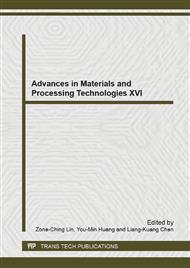p.437
p.445
p.451
p.459
p.465
p.473
p.481
p.491
p.499
Ga-Doped ZnO Films Deposited by Atmospheric Pressure Plasma
Abstract:
Deposition of gallium-doped zinc oxide (GZO) thin films using atmospheric pressure plasma jet (APPJ) system is presented in this work. High quality GZO films were demonstrated: The resistivity of as-deposited film achieves up to ~7×10-4 ohm-cm, which is comparable to that deposited using vacuum process. Further, the optical transmission with optimized thickness is > 89 % at wavelength of 550 nm. The Hall mobility increased as GZO deposition thickness increase to 300 nm. In order to study thermal stability of GZO thin films, the effect of thermal annealing on the optical and electrical properties was studied. Samples annealed in vacuum and in air showed opposite characteristics: resistivity decrease for vacuum annealing samples and increase for air annealing samples. Carrier reduction mainly attributed to the resistivity increase in air annealing. Mobility increases but carrier concentration decreases when samples were annealed in vacuum: The combined effects resulted in resistivity decrease to half of the prior-annealing values after 500 °C vacuum annealing. The GZO thin films used in capacitive touch sensors were also evaluated. We demonstrated that APPJ-deposited GZO thin films can be successfully applied to touch sensors in our work. These results indicate that our APPJ system can deposit good quality TCO films, which have potential to be applied in optoelectronics field.
Info:
Periodical:
Pages:
465-472
Citation:
Online since:
May 2014
Authors:
Price:
Сopyright:
© 2014 Trans Tech Publications Ltd. All Rights Reserved
Share:
Citation:


